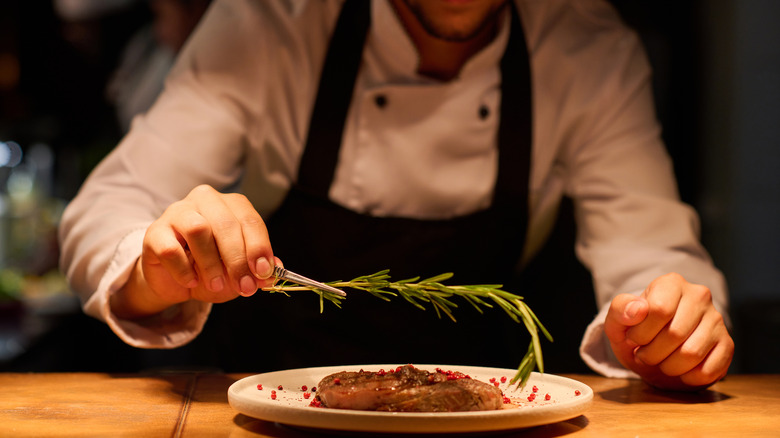Is there any higher form of public wealth display than fine dining? You call ahead, make your reservation, dress up in your Sunday best, and head to a ritzy location where all the tables are draped with elegant white cloth. Then you order off a menu packed with tersely described offerings that fall under headlines like “Fresh Catch” and “From the Farm.” The food is exceptional, no one is denying that, but when the bill reaches the table, it lands with a thud.
Expensive steakhouses are an American favorite, offering delicacies in the form of
Wagyu beef (the height of luxury)
, caviar, and poultry sandwiches decorated with fresh sprigs of parsley. But are they worth the price? Only you can decide for yourself. Places like these are not selling food alone — they’re selling a feeling, an atmosphere; an awareness of your place in the world, and the place of those who pass by the window on their way to Applebee’s. Here are expensive steakhouses where, to put it politely, you will get your money’s worth.
Read more:
Which US Steakhouse Chains Use The Best Quality Beef?
The Palm
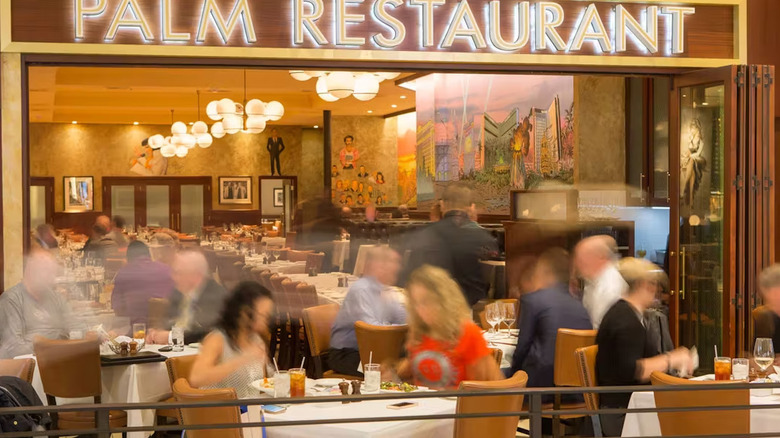
Starting off with the cheapest on the list (that’s right, it only gets worse from here), we have The Palm. It’s got a classic early 20th century vibe, decorating its website with things that scream “vintage” like photos of chefs taken in black and white, and hand-drawn ads that feature clean-shaven guys from the 1950s. This is the kind of restaurant that shows up inside the grand lobby of an expensive hotel. The restaurant also like to list the menu prices in plain numbers without dollar signs, preferring the look of “16” to “$16,” for example. This is a classic psychological technique based on actual research data that indicates people will spend more of their money when menu prices are listed with no dollar symbol.
But let’s get to the meat of it: This place serves some expensive steak. A 6-ounce center-cut filet will run you $44 dollars (or is it just 44?). Remember, this is one of the more forgiving restaurants on the list, too. The sauces alone cost almost as much as a kid’s meal at a normal restaurant. Would you pay $7 for brandy peppercorn sauce? If so, congratulations on your lucrative career, and enjoy your sauced-up Palm steak.
Shula’s Steakhouse

The
Shula’s
website says that the company “values the little things.” Well, there’s one little thing these steak makers value for sure, and that’s your money. Maybe that’s why it asks for so much of it. Shula’s is going for a kind of all-American vibe, noting that iy was born with the intent to carry on the legacy of famous NFL coach Don Shula. And while it no doubt maintains a standard of excellence that mirrors the greatness of the namesake, there’s no escaping the simple fact that it is charging food fees fit for a wealthy coach.
Check out some of these menu items, for example. At $34 for Atlantic salmon filet? Yikes. And the “Jumbo Lump Crab Cake”? That will set you back 41 smackers. But we’ve saved the best for last: It does not sell a steak for less than $48. Most of the steaks are much more expensive: $65 for a 16-ounce ribeye is a bit much for most restaurant goers. The 24-ounce porterhouse sounds delicious, but it comes in at a whopping $85. Can you imagine dropping that kind of money on one dinner? But, hey, if the restaurant has been in business since 1989, it must have found a way to please the clientele.
Fleming’s
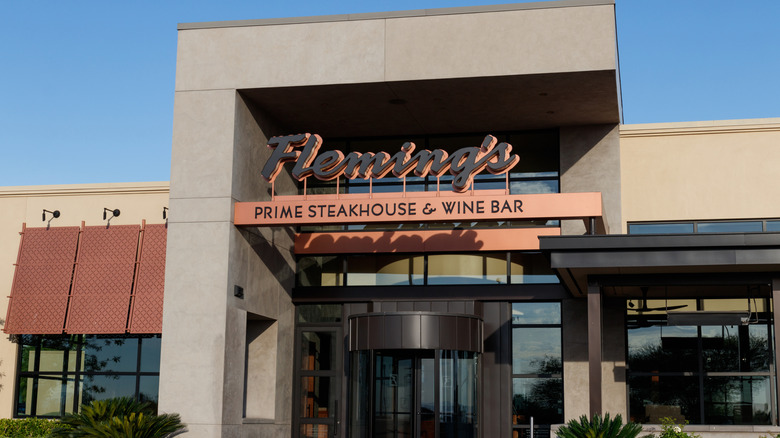
The outside of a Fleming’s is characterized by stark white and black colors, sharp angles, and tall windows. You can tell it’s a classy joint before you walk in the door. And classy means expensive. It’s got a pretty slick website with big, appetizing professional photos of the menu offerings, and it honestly looks pretty dang tasty. If you want a table at a Fleming’s, though, you will likely have to play it on the safe side and book a reservation.
It also specializes in
luxury cocktails
like the “Smoked Old Fashioned,” a literally smoky beverage
described as
“Basil Hayden Toast bourbon, savory five-spice syrup & aromatic bitters, complemented by rich oak smoke, poured table-side over signature ice.” It sounds amazing, and for $25, it had better be. But drinks are just a way to get started. The real high rollers will move onto the main menu where you can select things like the filet mignon for $67, or the “Prime Dry-Aged Ribeye” for $77. If this is too rich for your blood, wait until you see the Wagyu strip steak, which is listed at $140. Insert shocked exclamation here, right? Last and certainly not least is the grand finale of entrées, the “Chilled Shellfish Tower;” a $189 seafood colossus fit for a starved, beach-roving ogre. To be fair, this last item is meant to serve four to six diners, so if six people split it, that’s actually not so bad. It still comes out to $31 per person, though, and that’s assuming no one orders drinks.
Peter Luger

Peter Luger is a name that may conjure images of that old German pistol from the 1940s. This may be appropriate, because a trip to Peter Luger’s is a bit like shooting yourself in the wallet (though it’s
one of the best steakhouses in NYC
). The restaurant title’s classic Germanic font snugly encloses a minimalistic logo of a black laurel, which somehow triggers the impression that the food is worth the money, so kudos to the marketing team for that one. Peter Luger has been around since 1887 (the restaurant, not the man himself), so that’s plenty of time to perfect your steak cooking technique. And for these prices, that steak had better be perfect.
Peter Luger also runs that little scheme where it doesn’t place dollar signs next to the prices, but when you scan down to the “Surf” section of the menu, there are no prices at all. It just says that seafood is priced “by the pound.” One can imagine how pricey it must be that it’s disinclined to list numbers at all. But as for those that are listed, it’s the usual range of things. For a “single steak” of unknown size, you will pay $67.95. The rib steak is a hefty $89.95, and if you’re in the mood to throw money at seafood, you can try the dover sole entrée for $84.95.
Ruth’s Chris Steakhouse
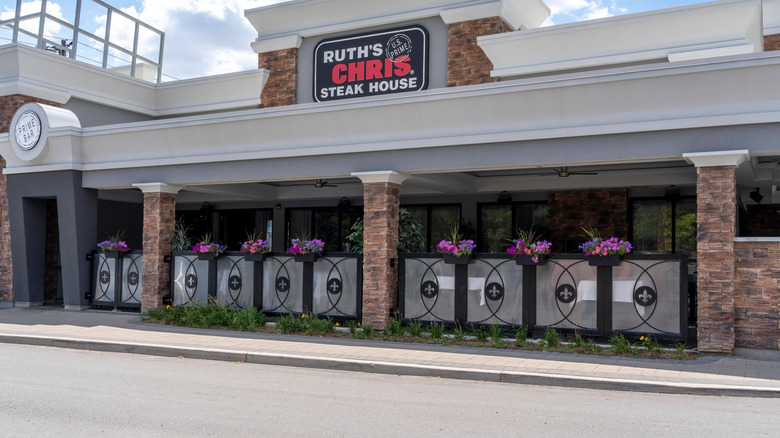
The strangest name on this list comes from the restaurant with the most down-to-earth feel. Ruth’s Chris Steakhouse was originally just “Chris Steakhouse” until the owner, Ruth, had to relocate the business due to a fire. Per a clause in the contract between herself and the restaurant’s original owner, Chris, she was not allowed to use the original name outside the original building. But the branding was so well-known that Ruth didn’t want to lose business over a name change. Hence, “Ruth’s Chris Steakhouse.” And she certainly didn’t lose any business — this place has dozens of locations, and it’s one of the biggest names in steak restaurants around the United States.
So everybody knows the name of the joint, and they know what kind of prices to expect. But if you want specifics, check this out: For a New York strip steak, it’s asking $61. That’s pretty standard for this type of steakhouse, but still a lot of cash to drop on your red meat fix. A good old-fashioned T-bone steak costs $72, and a “Cowboy Ribeye” will run you $80 — that’s pretty well up there even for a deluxe steakhouse. Of course, the cowboy steak is not exactly for light eaters, weighing in at 1,690 calories. That’s most of a grown man’s recommended caloric allotment in a 24-hour period, so maybe eat half and bring the rest home in a to-go box.
Smith & Wollensky
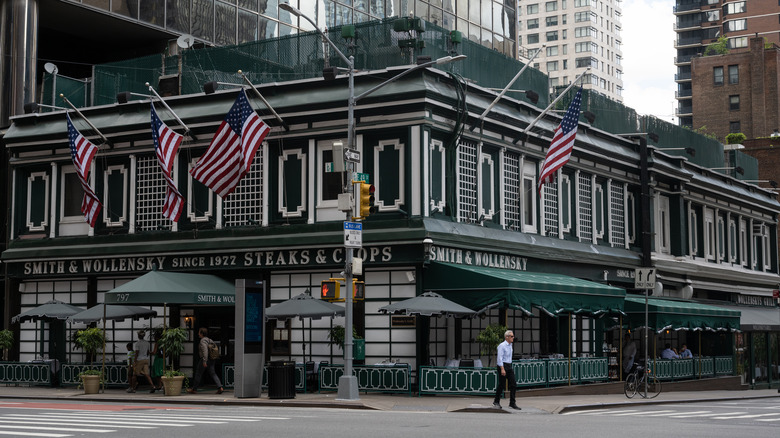
The Smith and Wollensky branding welcomes you to “America’s steakhouse.” But Americans pay as much as anyone else who enters those doors, and boy do they pay. Especially if they want to become members of the coveted Smith & Wollensky Club, a high-dining crew of elite well-to-do categorized into membership tiers based on how much you spend at the restaurant. It’s basically just a rewards program, but it’s free to join, which makes it essential for any frequent customer.
It’s a decent-sized chain with six locations around the U.S., each one boasting a classy look befitting any expensive steakhouse. But a good rule of thumb is that if the place has class, expect to put up the cash. This is confirmed by the menu, which is admittedly kind of fun with items like “Angry Shrimp” and even some grilled octopus. But looking at the steak section — charmingly referred to as the “Butcher’s Table” — it’s charging an even $70 for their 10-ounce “Coffee and Cocoa Rubbed Filet.” The “Gorgonzola Crusted Filet” is $75, and their crab filet, known as the “”Filet Oscar,” will run you a cool $88. No one is denying the quality of the food served, but the bill might leave a bad taste in your mouth.
Steak 48
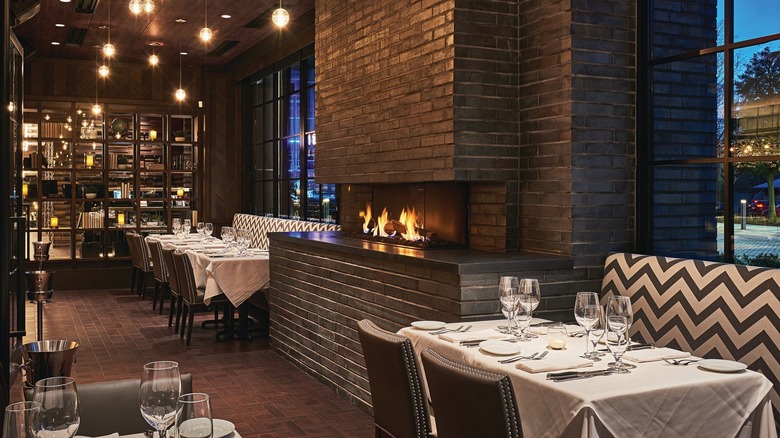
Steak 48 is the kind of minimalistic restaurant name that says “We don’t need a fancy title.” The brevity implies luxury, and that’s certainly what you’ll get (and pay for) at Steak 48. The website has a nice gallery page where you can check out pictures of the refined decor and frankly mouthwatering plates the restaurant is famous for. There is an art to food photography, and whoever the brand hired has clearly mastered it. Some of the dishes really exemplify the balance Steak 48 strikes between class and whimsy, like the oysters served on ice with a couple of little Tabasco bottles peeking from their icy nest at odd angles.
But it’s a plain-white tablecloth restaurant, which signals higher charges for the food on offer. One of the Caesar salads alone is $19, which is kind of a lot for romaine lettuce and a poached egg. It’s got a 3-ounce wine-fed steak for $120, which is the most expensive steak we’ve yet covered on this list. It offers plenty of other
steak cuts
that hover around the $60 to $70 range, which is par for the course at this point. But if you’re in the mood for a small shock, the Sasanian Imperial Osetra caviar is a $350 delicacy.
Mastro’s

How can you tell Mastro’s is expensive without peeking at the menu? Here’s a major clue: It has a dress code. Mastro’s does not permit such embarrassing thrift-store vibes as those emanating from sweatpants, ball caps, or sleeveless shirts. You certainly don’t want to dress like a schlub as you sip your $250 Round Pond wine (yes, that is the price of a single bottle). This is one of the larger steakhouse chains we’re covering, and it has multiple locations across multiple states. The cheapest item on the menu is the chicken piccata, which is only $22. But don’t mistake that for a lower-priced menu overall — the usual suspects make an appearance at standard upscale prices.
For a 12-ounce
bone-in filet
, it’s asking for $69. A dry-aged bone-in ribeye is $89, and a rack of lamb is $76. Those are the mid-range prices, though. Predictably, the Mastro’s menu really starts to climb when you hit the Wagyu section. An 8-ounce Wagyu New York steak is $150, and the 40-ounce Wagyu mammoth, the “Tomahawk Chop,” is a $250 slab of meat. On the other hand, there’s some creamed corn for $16. Imagine the look on the server’s face if you walked in and ordered that and nothing else.
The Capital Grille
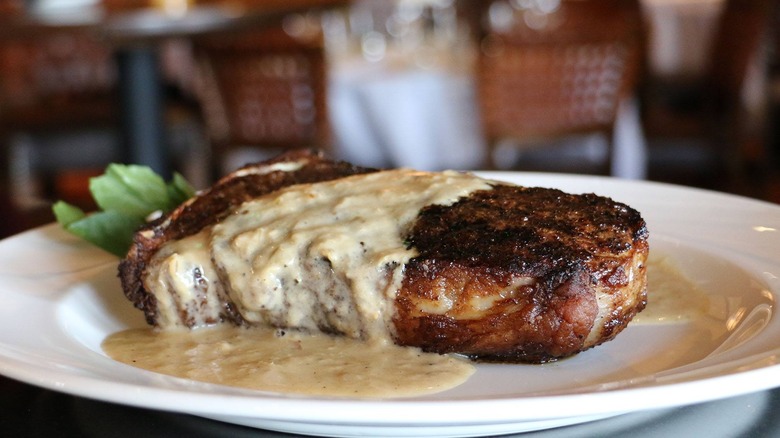
The Capital Grille is shooting for that old-timey spelling of “grill,” adding a fun “e” to the end for a shot of pure class (it is
one of the best steakhouse chains in the U.S.
, after all). On the website, you may notice a pair of clean hands twisting an orange rind into a small cocktail. Something about it just makes your intuition shout, “triple the price of normal food.” This time, your intuition is just about right. It’s got a fun range of desserts at fairly reasonable prices, like flourless chocolate espresso cake, or berries served with vanilla crème anglaise. But once you hit the beef section of the menu, it’s back to business as usual with prices that, were you chatting with a financial advisor, you’d be reluctant to mention paying.
Now, compared to other restaurants on this list, The Capital Grille is actually easier on your checking account. But compared to what you might call an “average joe” restaurant like Texas Roadhouse or Red Robin, this is still pretty expensive stuff. For example, the lobster and crab cake meal is a mere $26, which is way cheap in the world of upscale eateries. Of course, steak is basically the reason you visit a steakhouse, and these steaks are in the $60 to $80 range, placing it officially into the realm of the expensive.
STK Steakhouse

STK’s interior decoration varies from location to location, but prices remain pretty similar. And those prices are high. You’ll notice some of the online menus don’t include prices. For the budgeting steak lover, this is almost always a bad omen. STKs can be found in a variety of places around the U.S., and it even goes international with a few locations in Europe. You can tell by the decor that STK is going for a more sleek modern upscale ambience with a lot of rounded white surfaces and neon lights. It actually looks like a really fun place to eat at night, but the fun ain’t free.
Once you actually dig up an STK menu with prices listed, the results are honestly surprising. That is, if you frequent expensive steakhouses, the prices at STK are more forgiving than you’d expect. A 12-ounce New York strip steak is only $36, which is very reasonable in the context of what places like this typically charge. There are some pretty expensive steak toppings, though, like the $8 truffle butter. But thanks to the cheaper menu items, this feels like one of the most accessible “nice” steakhouses you could possibly visit. You could show up to STK and order some pan-roasted chicken for $26 without feeling like you’re conspicuously broke.
Morton’s

Morton’s
company mission is to “always exceed our guests’ expectations.” Well if you expect an 8-ounce filet mignon for under $50, you could say that your expectations will indeed be exceeded. The Morton’s website has a cool art deco thing going on, and, overall, the images and font make for quite a presentation. There’s a section called “The Experience,” which sounds less like a restaurant and more like a civilian space shuttle ride into orbit. But at the end of the day, it’s just another fine dining steak joint that aims to make customers feel cultured and refined. It does have a kind of fun origin story though: It grew around the core offering of a really tasty hamburger about 40 years ago.
Suspiciously, menu prices are a little difficult to track down, so you’re better off looking to Google for that info. There’s not much that really stands out on the menu, at least not as far as distinguishing this restaurant from similar ones. It serves 12-ounce filet mignon for $62, but the crab cut, filet oscar, is $64, which actually runs cheaper than the oscar at other nice steak places. Overall, the food is expensive, but it’s not quite as bank-breaking as the other restaurants on this list.
Urban Farmer
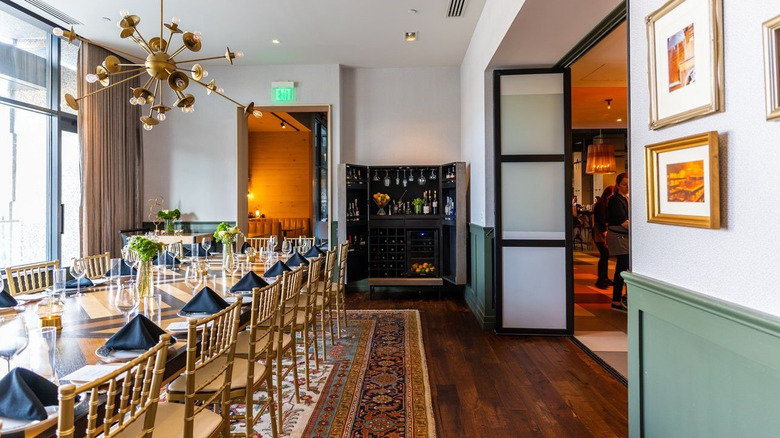
Urban Farmer almost sounds more like a clothing store for ranch hands with metropolitan sensibilities. In fact, it is yet another pricey steakhouse with a quaint selection of hearty sides like “local mushrooms.” These menu entries are detailed only in the briefest terms per the unwritten rule that says high-class dining must describe its menu items sans coordinating conjunctions and prepositions — in the case of the aforementioned mushrooms, that would be “caramelized onions, chives.”
Urban Farmer seems quite aware of how fine dining restaurants can be perceived — snooty, unapproachable. It has cultivated a much warmer and more personal image than the average upscale restaurant. The locations have a homey atmosphere that’s almost cozy. What it doesn’t have is affordable food — there’s a $90 Wagyu steak, a $120 tomahawk, and an $80 carpaccio. Are the restaurant locations beautiful? Is the food delicious? Yes and yes. But despite the refreshed approach to fine dining, Urban Farmer still targets that same demographic who can afford these more expensive nights out.
Want more food knowledge?
Sign up to our free newsletter
where we’re helping thousands of foodies, like you, become culinary masters, one email at a time.
Read the
original article on Food Republic
.

